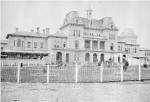Difference between revisions of "Portal:Featured Article Of The Week"
M-Explorer (talk | contribs) |
M-Explorer (talk | contribs) |
||
| (50 intermediate revisions by the same user not shown) | |||
| Line 1: | Line 1: | ||
{{FAformat | {{FAformat | ||
| − | |Title= | + | |Title= Kew Lunatic Asylum |
| − | |Image= | + | |Image= kew1885.png |
|Width= 150px | |Width= 150px | ||
| − | |Body= | + | |Body= The Kew Asylum was first opened in 1871 as a ward of Yarra Bend. For a short period Kew was also known as the "Metropolitan Asylum". Many of Kew's early patients were transferred from Yarra Bend and the Collingwood Asylum. In October 1872 Kew was proclaimed a separate institution from Yarra Bend. |
| − | + | After World War II there was a period of significant change in the treatment and prognosis for people with a mental illness. Drugs such as Lithium carbonate (discovered in 1948 by Australian psychiatrist Dr John Cade) and chlorpromazine (discovered in 1950's) lead to improvements in treatment. Thus many people with a mental illness could in many cases be treated in hospital for a shorter period and return to the community. The Mental Health Act of 1959 designated hospitals providing short-term diagnosis and accommodation as "psychiatric hospitals". Therefore any institution could have a section designated as a mental hospital for long-term or indefinite hospitalisation and a section designated as a psychiatric hospital for short term diagnosis and treatment of acute psychiatric illness. | |
| − | In the | + | In 1962 the decision was made to no longer house acute or short-term patients at Kew and therefore it was formally proclaimed a Mental Hospital under the Mental Health Act of 1959. Up until this time, Kew Mental Hospital was still colloquially known as 'Kew Asylum'. [[Kew Lunatic Asylum|Click here for more...]] |
| − | |||
| − | |||
| − | |||
| − | |||
}} | }} | ||
Revision as of 04:24, 9 August 2020
Featured Article Of The Week
Kew Lunatic Asylum
The Kew Asylum was first opened in 1871 as a ward of Yarra Bend. For a short period Kew was also known as the "Metropolitan Asylum". Many of Kew's early patients were transferred from Yarra Bend and the Collingwood Asylum. In October 1872 Kew was proclaimed a separate institution from Yarra Bend.
After World War II there was a period of significant change in the treatment and prognosis for people with a mental illness. Drugs such as Lithium carbonate (discovered in 1948 by Australian psychiatrist Dr John Cade) and chlorpromazine (discovered in 1950's) lead to improvements in treatment. Thus many people with a mental illness could in many cases be treated in hospital for a shorter period and return to the community. The Mental Health Act of 1959 designated hospitals providing short-term diagnosis and accommodation as "psychiatric hospitals". Therefore any institution could have a section designated as a mental hospital for long-term or indefinite hospitalisation and a section designated as a psychiatric hospital for short term diagnosis and treatment of acute psychiatric illness.
In 1962 the decision was made to no longer house acute or short-term patients at Kew and therefore it was formally proclaimed a Mental Hospital under the Mental Health Act of 1959. Up until this time, Kew Mental Hospital was still colloquially known as 'Kew Asylum'. Click here for more...
